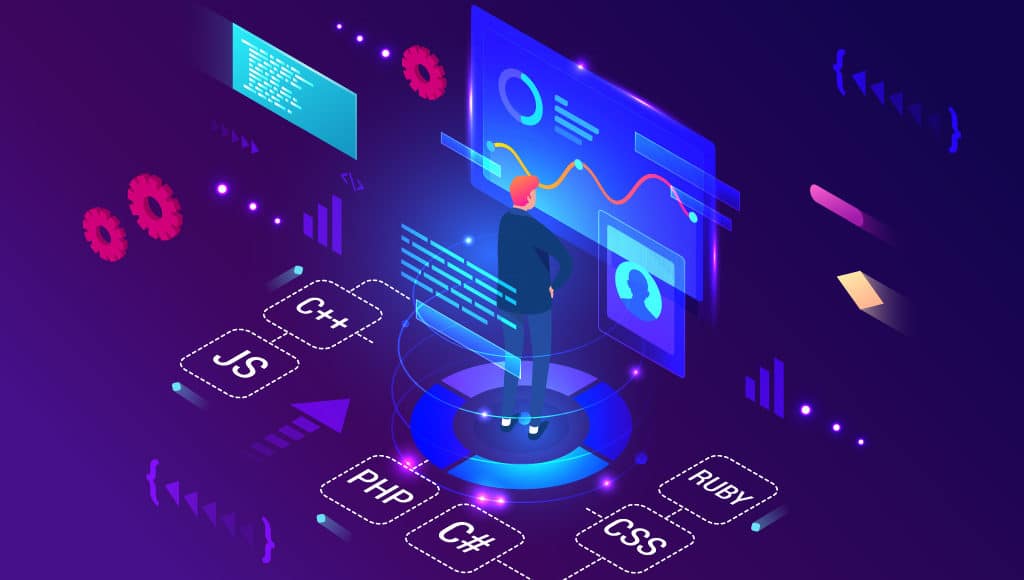Tech stacks are effectively a software developer’s toolkit, the key to creating functioning applications. The stack you choose influences the layout, infrastructure, design, and execution of applications.
The most popular tech stacks are flexible, comprehensive, and help developers build fast innovative applications. So when choosing a tech stack for your organization, it’s important to prioritize these superior options.
In this article, we’re going to explore the most popular tech stacks used by leading tech companies, such as Netflix.
What is a tech stack?
Tech stacks are a set of tools, technologies, programming languages, software applications, and frameworks that work together to build digital products or solutions such as websites, mobile, and web applications.
A ‘full’ tech stack usually comprises of two parts, which are:
- Front-end stack. This stack is used to develop the website or application’s client/user side and includes programming languages like CSS and HTML.
- Backend stack. This stack is used to develop the server-side and includes technologies like PHP, .NET, and Python.
Choosing the right full stack is crucial to developing agile, innovative, high-performance applications with user-friendly interfaces.
A look at the most popular tech stacks in software development.
Here’s a rundown of the five most popular tech stacks.
MEAN Stack
The MEAN stack is a framework based on Javascript used to develop applications. The open-source stack is popular amongst developers for its ease of use, flexibility, and agile performance.
The MEAN stack is comprised of:
- MongoDB database documentation. This database management system helps developers run applications across multiple operating systems, including Windows, Linux, and macOS.
- Express.Js, a minimalist framework for Node.js. Express.Js, is used to manage HTTP responses and requests, and its robust model for routing URLs is a plus.
- Angular.Js, a Javascript framework for front-end development. Angular.Js lets developers build interactive, dynamic websites by extending HTML tags.
- Node.Js server side.
The stack is ideal for real-time applications, but it also fares well for developing forums and management tools. Additionally, integrations between the stack’s components are seamless because of their mutual JavaScript and JSON base.
MERN Stack
The MERN stack contains three of the same components as MEAN, with React replacing Angular. But, what trade-offs are involved here?
Well, React gives you more flexibility. It uses Virtual DOM, so you can make changes more conveniently by leveraging virtual UIs, and component work is easier thanks to JSX.
However, because React is a library rather than a framework, it comes with significant limitations. MERN is gaining popularity because of its UI-first functionality, but MEAN still firmly holds its lead.
LAMP Stack
LAMP is one of the earliest, and most popular, open-source stacks for developing web applications. As a non-propriety stack, LAMP is cost-effective, and it’s versatile without compromising on performance.
The LAMP stack is made up of:
- Linux, the most popular open-source operating system. It’s known for its versatility and has a strong user community.
- Apache, the stack’s web server. It uses HTTP to serve web assets, making applications easy to access from a public domain. Apache is well-established and has robust features, making it popular amongst websites.
- MySQL, an open-source relational database management system. MySQL fares well for large, structured sites that need to translate structural elements to the backend.
- PHP, a scripting language that pairs well with Apache, allowing developers to create interactive, dynamic web pages. PHP is popular as an efficient, flexible language.
Serverless Stack
Cloud giants like Google and Amazon Web Services (AWS) offer serverless architecture. The technology has gained momentum in recent years, primarily because its versatile, cost-effective, and is designed to handle large loads.
Websites and applications built on serverless stacks can scale instantly and seamlessly, making it a popular choice for major players like Netflix.
If you’ve ever wondered how Netflix caters to millions of users, streaming films simultaneously, without crashing, serverless technology is the answer. The platform uses the cloud infrastructure to scale up according to demand, and consistently deliver 1080p broadcast quality.
Ruby on Rails
Ruby is a versatile programming language, and Ruby on Rails (RaR) is an integrated environment powered by the language. The RoR framework is extremely scalable and flexible, allowing developers to make modifications and improvements without limitations.
RoR also cuts down development times with its rich libraries, default structures for web pages, software packages, and additional utilities. The framework is also compatible with popular languages like HTML, CSS, and JavaScript for creating user interfaces.
How can you evaluate candidates for these tech stacks?
Leading tech organizations use skills testing and technical screening to optimize their talent acquisition. The idea behind skills testing is to vet applicants for their practical, problem-solving skills, rather than to rely on experience alone.
Big Tech corporations, including FAANG, leverage technical screenings and coding challenges in their interviewing process. The emphasis on problem solving and technical skills helps these organizations land the best tech talent.
So if you’re looking to evaluate candidates for popular tech stacks in software development, you might want to consider conducting skills assessments. You can leverage a skills testing platform to create a custom, stack-specific test to reliably vet candidates.
Evaluating candidates for popular tech stacks in software development with WeCP
WeCP (We Create Problems) is a robust tech recruitment solution for conducting technical screenings, remote interviews, and skills assessment tests.
WeCP’s repository contains over 0.2 million questions for assessing over 2000 tech skills, with specific questions for MEAN and MERN stacks. You can also design custom tests for different stacks, vetting applicants’ programming skills in languages like Python and Ruby.
So if you need help acquiring the best tech talent, get in touch with us. We’ll help you plan a reliable, candidate-first skills assessment to secure the most capable hires.

